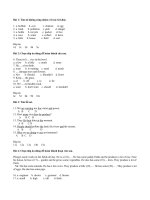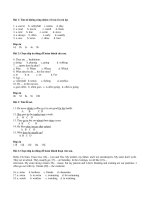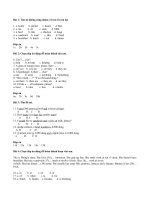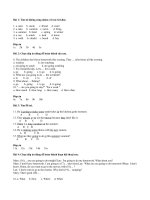Đáp án trắc nghiệm tiếng anh thương mại en51 thi trắc nghiệm
Bạn đang xem bản rút gọn của tài liệu. Xem và tải ngay bản đầy đủ của tài liệu tại đây (111.54 KB, 25 trang )
ĐÁP ÁN TRẮC NGHIỆM TIẾNG ANH THƯƠNG MẠI EN51 _THI
TRẮC NGHIỆM
Ghi chú (Đ) là đáp án đúng và Có bản dịch tiếng việt ở cuối tài liệu
Câu 1
The statement “Please send us a corrected invoice for $9,479.” is in
a. Problem
b. Background
c. Closing
d. Solution(Đ)
Câu 2
……make a memo lengthy
a. Always
b. Usually
c. Often
d. Never(Đ)
Câu 3
A letter of complaint usually consists of
a. 5 parts(Đ)
b. 6 parts
c. 3 parts
d. 4 parts
Câu 4
A memo contains
a. From, Date, , and Message sections
b. To, Date, , and Message sections
c. To, From, Date, Subject Headings, and Message sections(Đ)
d. To, From, Date, and Message sections
Câu 5
1
A memo is a ………..communication conveying your thoughts, reactions or
opinion on something
a. Long but to the point
b. Short and to the point(Đ)
c. Short or to the point
d. Short and indirect
Câu 6
A memo
a. Can’t be signed
b. Does not need to be signed(Đ)
c. Must be signed
d. Should be signed
Câu 7
A report requires …….underlined at the top
a. A date
b. A name
c. An address
d. A title(Đ)
Câu 8
An application letter is divided into
a. Five paragraphs
b. Four paragraphs(Đ)
c. Three paragraphs
d. Two paragraphs
Câu 9
An application letter is
a. To complain
b. To make an enquiry
c. To request an action
2
d. To apply for a job(Đ)
Câu 10
Dear Sir/Madam is the salutation ……. of the business letter
a. At the beginning(Đ)
b. At the end
c. In the middle
d. Not necessary
Câu 11
How many types of email are there?
a. 2(Đ)
b. 1
c. 4
d. 3
Câu 12
If the letter is going to someone whose name you do not know, it starts with
a. Dear John/ Marry
b. Dear Mr. / Ms. Brown
c. Dear Sir or Dear Madam or Dear Sir/Madam(Đ)
d. Dear Mr. John/ Ms. Marry, ……
Câu 13
If you begin the letter with Dear Sir/Madam, at the end of your letter you
should include the closing phrase:
a. Best wishes
b. Yours faithfully(Đ)
c. Bests regards
d. Yours sincerely
Câu 14
If you know the name of the recipient, you end the letter with
a. Yours sincerely(Đ)
3
b. Best wishes
c. Bests regards
d. Yours faithfully
Câu 15
If your memo is longer than a page, you may want to include a separate …
a. Opening segment
b. Summary segment(Đ)
c. Discussion segment
d. Closing segment
Câu 16
In a letter of complaint, we describe the cause and effect in
a. Background
b. Problem(Đ)
c. Solution
d. Warning
Câu 17
In a letter of complaint, we describe the situation in
a. Background(Đ)
b. Solution
c. Problem
d. Closing
Câu 18
In a letter of complaint, we describe what is expected from the recipient
in
a. Background
b. Solution
c. Problem
d. Closing(Đ)
Câu 19
4
In a letter of complaint, we describe what should be done to solve the
problem in
a. Background
b. Closing
c. Problem
d. Solution(Đ)
Câu 20
One of the advantages of emails over normal “snail- mail” letters is that
they are …..
a. Quick and indirect
b. Quick or direct
c. Slow but direct
d. Quick and direct(Đ)
Câu 21
Paragraph 1 in a letter of request is to
a. Cover relevant background information and details
b. Provide contact information
c. Reiterate action and/or thank
d. Request specific information or action(Đ)
Câu 22
Paragraph 1 in an application letter is
a. To describe your practical work experience
b. To ask for an interview
c. To state your enthusiasm and interest
d. To state that you are applying for the job(Đ)
Câu 23
Paragraph 2 in a letter of request is to
a. Cover relevant background information and details(Đ)
b. Reiterate action and/or thank
5
c. Request specific information or action
d. Provide contact information
Câu 24
Paragraph 2 in an application letter is
a. To state that you are applying for the job
b. To state your enthusiasm and interest
c. To describe your practical work experience(Đ)
d. To ask for an interview
Câu 25
Paragraph 3 in a letter of request is to
a. Reiterate action and/or thank
b. Request specific information or action
c. Cover relevant background information and details
d. Provide contact information(Đ)
Câu 26
Paragraph 4 in a letter of request is to
a. Reiterate action and/or thank(Đ)
b. Cover relevant background information and details
c. Provide contact information
d. Request specific information or action
Câu 27
Reports are matter of fact and to the point. Language is therefore ……
a. Informal
b. Neutral or factual
c. Neutral and factual(Đ)
d. Subjective
Câu 28
The expression “Hi/Hello + name ...……….” in an email is an informal
a. Headline
6
b. Opening
c. Conclusion
d. Salutation(Đ)
Câu 29
The expression “Hope to hear from you soon .” in an email is an informal
a. Headline
b. Opening
c. Conclusion(Đ)
d. Salutation
Câu 30
The expression “I am writing to……….” in an email is in the
a. Salutation
b. Closing
c. Opening(Đ)
d. Headline
Câu 31
The expression “I recommend that ….” is used in
a. Conclusions
b. Proceedings
c.
Findings
d. Recommendations(Đ)
Câu 32
The expression “I’m writing from __________ and I was wondering if you
could…” is used to
a. Provide contact information
b. Request specific information or action(Đ)
c. Reiterate action and/or thank
d. Cover relevant background information and details
7
Câu 33
The expression “If you have questions about (my request / my order),
please contact me at…” is used to
a. Provide contact information(Đ)
b. Reiterate action and/or thank
c. Request specific information or action
d. Cover relevant background information and details
Câu 34
The expression “Just a quick note to……….” in an email is an informal
a. Closing
b. Salutation
c. Headline
d. Opening(Đ)
Câu 35
The expression “Looking forward to your reply……….” in an email is in
the
a. Conclusion(Đ)
b. Salutation
c. Opening
d. Headline
Câu 36
The expression “Yours sincerely.” in an email is a very formal and rarely
used
a. Opening
b. Headline
c. Salutation
d.Close(Đ)
Câu 37
The 'From' section in a memo contains
a. The date
8
b. The name of the sender(Đ)
c. The name of the receiver
d. The main idea
Câu 38
The heading segment should include
a. From, Date,
b. To, Date,
c. To, From, Date
d. To, From, Date, Subject(Đ)
Câu 39
The report ……be signed and dated
a. Can’t
b. Should(Đ)
c. Shouln’t
d. Mustn’t
Câu 40
The statement “I am writing to inform you that the goods we ordered from
your company have not been supplied correctly.” is in
a. Solution
b. Closing
c. Problem
d. Background(Đ)
Câu 41
The statement “Please send us a corrected invoice for $9,479.” is in
a. Closing
b. Background
c. Problem
d. Solution(Đ)
Câu 42
9
The Subject Line in an email is the
a. Closing
b. Headline(Đ)
c. Salutation
d. Opening
Câu 43
The Subject Line in an email should be
a. Indirect
b. Informal
c. Short(Đ)
d. Long
Câu 44
The 'Subject' section in a memo contains
a. The date
b. The name of the sender
c. The main idea(Đ)
d. The name of the receiver
Câu 45
The 'To' section in a memo contains
a. The name of the receiver(Đ)
b. The name of the sender
c. The date
d. The main idea
Câu 46
There are ……. basic reasons to write a memo
a. 3(Đ)
b. 2
c. 4
d. 5
10
Câu 47
We clearly state the purpose of communication in the
a. “Date” section
b. “To” section
c. Subject line(Đ)
d. “From” section
Câu 48
We explain what the facts mean in
a. Findings
b. Proceedings
c.Recommendations
d.Conclusions(Đ)
Câu 49
We explain what the report is about in
a. Findings
b. Proceedings
c. Terms of reference(Đ)
d. Conclusions
Câu 50
We should close the memo with a ………..ending that states what actions
we want the reader to take
a. Threatening
b. Friendly(Đ)
c. Unfriendly
d.Warning
Câu 51
We suggest what action(s) should be done in
a. Findings
b.Recommendations(Đ)
11
c.Conclusions
d. Proceedings
Câu 52
We write memos with purpose and make that purpose known in the
a. First paragraph(Đ)
b. Third paragraph
c. Second paragraph
d. Fourth paragraph
Câu 53
When we received a complaint letter, if the cause of the problem were
beyond our responsibility, we could
a. Do nothing
b. Reject the complaint(Đ)
c. Accept the complaint
d. Ignore the complaint
Câu 54
When we received a complaint letter, if we are sure that we are at fault, we
should
a. Ignore the complaint
b. Accept the complaint(Đ)
c. Reject the complaint
d. Do nothing
Câu 55
When we write a report, presentation and style are
a. Important(Đ)
b. Not important
c. Useless
d. Not necessary
Câu 56
12
When writing a memo, we should keep paragraphs ….
a. Formal
b. Informal
c. Short(Đ)
d. Long
Câu 57
When written properly, memos can be ……. in connecting the concern or
issue of the writer with the best interests of the reader
a. Very effective(Đ)
b. Unnecessary
c. Impolite
d. Inconvenient
***
BẢN DỊCH TIẾNG VIỆT
ĐÁP ÁN TRẮC NGHIỆM TIẾNG ANH THƯƠNG MẠI EN51 _THI
TRẮC NGHIỆM
Ghi chú (Đ) là phản hồi đúng
Có bản dịch tiếng việt ở tài liệu cuối cùng
Câu 1
Tuyên bố "Vui lịng gửi cho chúng tơi hóa đơn đã sửa với số tiền 9.479
USD." trong
a. Vấn đề
b. Lý lịch
c. Đóng cửa
d. Giải(Đ)
Câu 2
……làm một bản ghi nhớ dài dịng
a. Ln luôn
b. Thường xuyên
c. Thường
13
d. Không bao giờ(Đ)
Câu 3
Một lá thư khiếu nại thường bao gồm
a. 5 phần(Đ)
b. 6 phần
c. 3 phần
d. 4 phần
Câu 4
Một bản ghi nhớ có chứa
a. Các phần Từ, Ngày và Tin nhắn
b. Các phần Đến, Ngày và Tin nhắn
c. Phần Đến, Từ, Ngày, Tiêu đề Chủ đề và Tin nhắn(Đ)
d. Các phần Đến, Từ, Ngày và Tin nhắn
Câu 5
Một bản ghi nhớ là một ………..sự giao tiếp truyền tải những suy nghĩ,
phản ứng hoặc quan điểm của bạn về điều gì đó
a. Dài nhưng đúng ý
b. Ngắn gọn và đúng trọng tâm(D)
c. Ngắn gọn hoặc đúng trọng tâm
d. Ngắn gọn và gián tiếp
Câu 6
Một bản ghi nhớ
a. Không thể ký được
b. Không cần phải ký (Đ)
c. Phải được ký
d. Nên được ký kết
Câu 7
Một báo cáo yêu cầu …….được gạch chân ở trên cùng
a. Một buổi hẹn hò
14
b. Một cái tên
c. Một địa chỉ
d. Một tiêu đề(Đ)
Câu 8
Một lá thư xin việc được chia thành
a. Năm đoạn văn
b. Bốn đoạn(Đ)
c. Ba đoạn văn
d. Hai đoạn văn
Câu 9
Một lá thư xin việc là
a. Phàn nàn
b. Để thực hiện một cuộc điều tra
c. Để yêu cầu một hành động
d. Để xin việc (Đ)
Câu 10
Thưa ông/bà là lời chào ……. của lá thư kinh doanh
a. Lúc đầu(Đ)
b. Cuối cùng
c. Ở giữa
d. Khơng cần thiết
Câu 11
Có bao nhiêu loại email?
a. 2(Đ)
b. 1
c. 4
d. 3
Câu 12
15
Nếu lá thư được gửi đến một người mà bạn khơng biết tên, nó sẽ bắt đầu
bằng
a. John thân mến/ Cưới đi
b. Thưa ông/bà Brown
c. Dear Sir hoặc Dear Madam hoặc Dear Sir/Madam(Đ)
d. Kính gửi ơng John/ bà Marry, ……
Câu 13
Nếu bạn bắt đầu bức thư bằng Dear Sir/Madam, ở cuối bức thư bạn nên
bao gồm cụm từ kết thúc:
a. Lời chúc tốt nhất
b. Trân trọng(Đ)
c. Lời chào trân trọng nhất
d. Trân trọng
Câu 14
Nếu bạn biết tên người nhận, bạn kết thúc bức thư bằng
a. Trân trọng(Đ)
b. Lời chúc tốt nhất
c. Lời chào trân trọng nhất
d. Trân trọng
Câu 15
Nếu bản ghi nhớ của bạn dài hơn một trang, bạn có thể muốn thêm một …
a. Đoạn mở đầu
b. Đoạn tóm tắt(Đ)
c. Phần thảo luận
d. Đoạn kết
Câu 16
Trong thư khiếu nại, chúng tôi mô tả nguyên nhân và kết quả trong
a. Lý lịch
b. Vấn đề(Đ)
16
c. Giải pháp
d. Cảnh báo
Câu 17
Trong thư khiếu nại, chúng tơi mơ tả tình huống ở
a. Nền(Đ)
b. Giải pháp
c. Vấn đề
d. Đóng cửa
Câu 18
Trong thư khiếu nại, chúng tơi mơ tả những gì người nhận mong đợi
TRONG
a. Lý lịch
b. Giải pháp
c. Vấn đề
d. Đóng(Đ)
Câu 19
Trong thư khiếu nại, chúng tơi mơ tả những gì cần làm để giải quyết vấn đề
a. Lý lịch
b. Đóng cửa
c. Vấn đề
d. Giải(Đ)
Câu 20
Một trong những lợi thế của email so với những bức thư “thư ốc sên” thơng
thường là chúng…..
a. Nhanh chóng và gián tiếp
b. Nhanh chóng hoặc trực tiếp
c. Chậm nhưng trực tiếp
d. Nhanh chóng và trực tiếp(Đ)
Câu 21
17
Đoạn 1 trong thư yêu cầu là
a. Bao gồm thông tin cơ bản và chi tiết có liên quan
b. Cung cấp thông tin liên lạc
c. Nhắc lại hành động và/hoặc cảm ơn
d. Yêu cầu thông tin hoặc hành động cụ thể(Đ)
Câu 22
Đoạn 1 trong thư xin việc là
a. Để mô tả kinh nghiệm làm việc thực tế của bạn
b. Để yêu cầu một cuộc phỏng vấn
c. Để bày tỏ sự nhiệt tình và quan tâm của bạn
d. Để nói rằng bạn đang xin việc (Đ)
Câu 23
Đoạn 2 trong thư yêu cầu là
a. Bao gồm thông tin cơ bản và chi tiết có liên quan (Đ)
b. Nhắc lại hành động và/hoặc cảm ơn
c. Yêu cầu thông tin hoặc hành động cụ thể
d. Cung cấp thông tin liên lạc
Câu 24
Đoạn 2 trong thư xin việc là
a. Để nói rằng bạn đang nộp đơn xin việc
b. Để bày tỏ sự nhiệt tình và quan tâm của bạn
c. Để mô tả kinh nghiệm làm việc thực tế của bạn (Đ)
d. Để yêu cầu một cuộc phỏng vấn
Câu 25
Đoạn 3 trong thư yêu cầu là
a. Nhắc lại hành động và/hoặc cảm ơn
b. Yêu cầu thông tin hoặc hành động cụ thể
c. Bao gồm thông tin cơ bản và chi tiết có liên quan
d. Cung cấp thông tin liên hệ(Đ)
18
Câu 26
Đoạn 4 trong thư yêu cầu là
a. Nhắc lại hành động và/hoặc cảm ơn(Đ)
b. Bao gồm thông tin cơ bản và chi tiết có liên quan
c. Cung cấp thơng tin liên lạc
d. Yêu cầu thông tin hoặc hành động cụ thể
Câu 27
Các báo cáo là vấn đề thực tế và đi vào trọng tâm. Vì vậy, ngơn ngữ là ……
a. Khơng chính thức
b. Trung lập hoặc thực tế
c. Trung lập và thực tế(D)
d. chủ quan
Câu 28
Biểu thức “Xin chào/Xin chào + tên ………….” trong một email là khơng
chính thức
a. Tiêu đề
b. Khai mạc
c. Phần kết luận
d. Lời chào(Đ)
Câu 29
Biểu thức "Hy vọng sớm nhận được phản hồi từ bạn." trong một email là
khơng chính thức
a. Tiêu đề
b. Khai mạc
c. Kết luận(Đ)
d. Lời chào
Câu 30
Câu nói “Tơi đang viết thư cho……….” trong một email nằm trong
a. Lời chào
19
b. Đóng cửa
c. Khai mạc(Đ)
d. Tiêu đề
Câu 31
Câu nói “Tơi khuyên bạn nên…” được sử dụng trong
a. Kết luận
b. Thủ tục tố tụng
c.Những phát hiện
d. Khuyến nghị(Đ)
Câu 32
Câu “Tôi đang viết từ __________ và tơi khơng biết liệu bạn có thể…” được
sử dụng để
a. Cung cấp thông tin liên lạc
b. Yêu cầu thông tin hoặc hành động cụ thể(Đ)
c. Nhắc lại hành động và/hoặc cảm ơn
d. Bao gồm thông tin cơ bản và chi tiết có liên quan
Câu 33
Cụm từ “Nếu bạn có thắc mắc về (u cầu của tơi/đơn đặt hàng của tơi), vui
lịng liên hệ với tơi theo số…” được sử dụng để
a. Cung cấp thông tin liên hệ(Đ)
b. Nhắc lại hành động và/hoặc cảm ơn
c. Yêu cầu thông tin hoặc hành động cụ thể
d. Bao gồm thông tin cơ bản và chi tiết có liên quan
Câu 34
Biểu thức “Chỉ là một ghi chú nhanh cho……….” trong một email là khơng
chính thức
a. Đóng cửa
b. Lời chào
c. Tiêu đề
d. Khai mạc(Đ)
20









